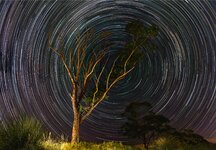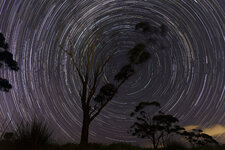Hello 
The Altona Foreshore Reserve is a protected wetlands area about 15km southwest of the city of Melbourne, in Victoria. I come here quite often as it has great city views as well as beautiful wetland native wildlife. The creeks and estuaries closer to my own home all feed down to these wetlands along what is called Skeleton Creek. This creek is where I have found many Maratus (peacock jumping spiders) and also where my brother takes many of his bird and wildlife photography.
Another photography style I like to do in these wetlands is astrophotography, in this shot I have put together about 500 shots which took about 4 hours of shooting to create the background star trails. I have done star trails in the past but this was my first time combining the technique with light painting. I used a torch to light the tree and the ground around it. The tree was light painted using about 18 photos, I used Sequator to create the star trails and then photoshop to combine the light painted foreground. This was one of the hardest edits and photoshop projects I have done so far, the star trail was pretty easy but where I may have been a bit too ambitious was in choosing a semi dead eucalyptus tree as my foreground, even a small amount of wind shook the leaves and branches and re-aligning these in the 18 shot composite was a nightmare. After months of editing and playing with it I am happy with it but its not perfect. If i had the choice again I would use something more steady like a piece of farm equipment or a building of some type, anything that wont move around with wind.
The gumtree eucalyptus I chose was half dead, I placed the live side of the tree over the spin point on purpose, thought it added a cool touch. Keeping light polution down in the scene was tricky considering the amount of light and proximity to a major city. Hope you like the photo

Here is what the star trail looks like without the light painted foreground..

The Altona Foreshore Reserve is a protected wetlands area about 15km southwest of the city of Melbourne, in Victoria. I come here quite often as it has great city views as well as beautiful wetland native wildlife. The creeks and estuaries closer to my own home all feed down to these wetlands along what is called Skeleton Creek. This creek is where I have found many Maratus (peacock jumping spiders) and also where my brother takes many of his bird and wildlife photography.
Another photography style I like to do in these wetlands is astrophotography, in this shot I have put together about 500 shots which took about 4 hours of shooting to create the background star trails. I have done star trails in the past but this was my first time combining the technique with light painting. I used a torch to light the tree and the ground around it. The tree was light painted using about 18 photos, I used Sequator to create the star trails and then photoshop to combine the light painted foreground. This was one of the hardest edits and photoshop projects I have done so far, the star trail was pretty easy but where I may have been a bit too ambitious was in choosing a semi dead eucalyptus tree as my foreground, even a small amount of wind shook the leaves and branches and re-aligning these in the 18 shot composite was a nightmare. After months of editing and playing with it I am happy with it but its not perfect. If i had the choice again I would use something more steady like a piece of farm equipment or a building of some type, anything that wont move around with wind.
The gumtree eucalyptus I chose was half dead, I placed the live side of the tree over the spin point on purpose, thought it added a cool touch. Keeping light polution down in the scene was tricky considering the amount of light and proximity to a major city. Hope you like the photo

Here is what the star trail looks like without the light painted foreground..

Last edited:
